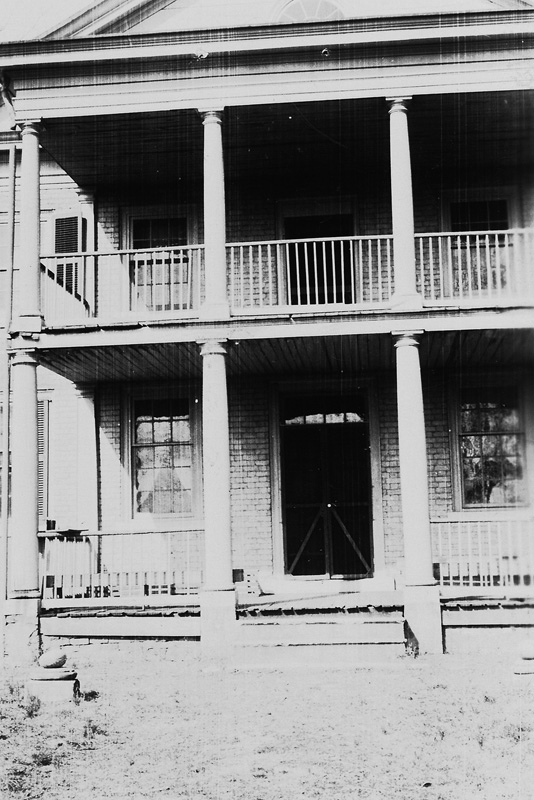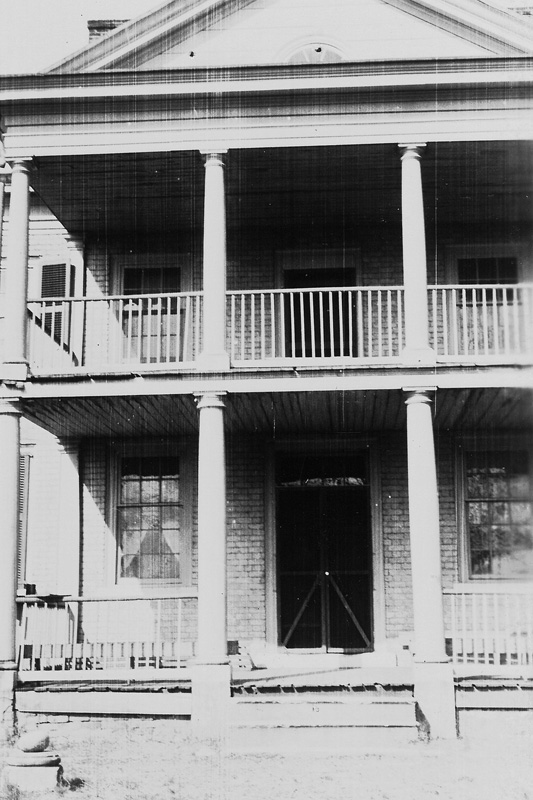
-

-
WORKS PROGRESS ADMINISTRATION OF VIRGINIA
HISTORICAL INVENTORY
102
COUNTY: Spotsylvania
CLASS: Home
Photograph
SEE PICTURE COLLECTION
---"NOTTINGHAM"---
This write-up is a part of the Virginia W.P.A.
Historical Inventory Project sponsored by the
Virginia Conservation Commission under the
direction of its Division of History. Credit to both
the Commission and W.P.A. is requested for
publication, in whole or in part. Unless otherwise
stated, this information has not been checked for
accuracy by the sponsor.
Research made by
Sue K. Gordon,
Fredericksburg, Virginia. December 29, 1936.
--------------------------------------------------------
5P-102
1. SUBJECT:
"Nottingham".
2. LOCATION:
7 miles from Fredericksburg, Virginia on Route #2, or Tidewater Trail.
This road leads south from Fredericksburg, by way of Princess Anne
Street. Follow this road for 6.5 miles then turn to your left, east,
towards the river and go .5 miles.
3. DATE:
About 1774.
4. OWNERS:
This tract of land was owned by Governor Spotswood from 1722 to 1740.
It was owned by his heirs from 1740 to 1834.
Mr. William I. Dickinson and his heirs have owned it since 1834.
5. DESCRIPTION
Of Colonial architecture, some of the floors, door panelling etc. are
original. It is of brick construction, with a hall through the middle,
a room on each side and a pillared porch of stone. A porch has been
added upstairs over the front porch. There is a boxed in stairway in
the front as you enter. The baseboards are hand carved as is the pan-
elling around the window, but not as elaborately as in many of the
old homes.
You can see there were brick walks, circular driveways and evidently
a brick walkway leading from the side of the house to a kitchen, but
no remnants of the kitchen are left. The house has two stories, the
rooms are rather small and there is a fanlight over the front door.
There are still several of the original trees at a distance from the
dwelling. Though ragged and broken, they stand majestically, as if
they were guarding the old manor.
6. HISTORICAL SIGNIFICANCE:
The first dwelling at "Nottingham was evidently built about 1774 and
by General Alexander Spotswood. (2) It burned and the present house
was erected by Mr. W. L. McCarthy Spotswood. A rather amusing incident
is told about this. Mr. Taliaferro, Mr. Spotswood's near neighbor,
commented on the porch, saying that it reminded him very much of a
turkey's tail. Mr. Spotswood resent this so much that it nearly re-
sulted in a duel. I have been to the house and in it, but I cannot
see the resemblance.
I regret to relate, that like a great many of the old Colonial homes
in Virginia, this one is not kept up at all. The fine old farm is
well cultivated and still yields abundant crops, but there is nothing
left in the house to denote the time that General Alexander Spots-
wood (2) lived there with his young wife.
------------------------------------------------------------
5P-102
2.
I have been told that at one time the river right in front of this
home was forty feet deep and there is a sand bar which used to pre-
vent vessels from coming up the river. It was very difficult to get
them by this obstruction and it was always called "Spotswood's Bar.
There are also indications that at one time the river ran one mile
further inland than it does now.
Mr. William Lawrence McCarthy Spotswood, at one time owner of this
estate, married Catherine Anne Jones. She was buried in what is now
the yard at "Nottingham". There is no mark on any kind at her grave.
When General Alexander Spotswood (2) resided at "Nottingham" the por-
traits of Governor Spotswood, Lady Spotswood and of General Elliott
Spotswood, half brother of the Governor, hung on the old walls of
"Nottingham". When Mr. Lawrence McCarthy Spotswood purchased "Sed-
ley Lodge" near Rapidan, Virginia, and sold "Nottingham", the por-
traits were taken there. "Sedley Lodge" no longer belongs to anyone
by the name of Spotswood and is in poor repair. These portraits
are now in the State Library.
The "Sedley Lodge" portrait of the Governor has been daguerreotyped
in miniature and the daguerreotype was in the possession of the Rev.
Philip Slaughter some years ago. It represents him in full court
dress, scarlet velvet, elegant tie of the cravat which is brought
down on the breast and then tied, fine noble looking face and figure.
Mr. William Lawrence McCarthy Spotswood had several brothers and I
shall speak of them later.
This old dwelling has been added to and remodeled and, as stated a-
bove, is in rather poor repair.
Governor Alexander Spotswood never lived at "Nottingham, He resided
at Germanna and his dwelling there was destroyed by fire through an
accident of an overseer in trying to melt lead from the roof.
The Spotswood arms were engraved on the silver plate at "Nottingham."
"Nottingham is evidently named for the county or place in England as
it was near there that Alexander Spotswood (2) and his brother John,
boarded and attended school.
There is an old original kitchen in the yard of "Nottingham" and very
unique in the way it is built. It is of brick construction with boards
over the bricks. It is within a short distance of the house and you
can readily see where the old brick walk to the house was.
Mr. W. L. McCarthy Spotswood had several brothers who were connect-
ed with the army and the navy. William Augustine Washington Spots-
wood was a surgeon in the United States Navy and was a surgeon gen-
eral in the Confederate States Navy. Captain Charles Fenton Mercer
Spotswood was in the United States and Confederate States Navies. He
had charge of harbor defenses when Norfolk was besieged.
Their brother Captain John Alexander Spotswood had command of the
first sloop of War Deleware, and was supposedly lost at sea. Another
------------------------------------------------------------------
5P-102
3.
brother was George Washington Spotswood, a lieutenant in the War of
1812.
The second owner of "Nottingham" was William I. Dickinson, a very
wealthy planter. It is now in the possession of Rev. William Morton,
Episcopal minister and grandson of William I. Dickinson. Rev. Morton's
mother was a daughter of William I. Dickinson and she married Dr. C.
B. Morton. Dr. Morton, deceased, was a surgeon in the Confederate Army.
Mr. and Mrs. Moore, tenants, are now living in the house and the cul-
tivation of the farm is supervised by Mr. J. Y. Dickinson, cousin of
Rev. Morton.
Mary Randolph Spotswood, daughter of Alexander Spotswood (2) was mar-
ried to Francis T. Thornton on June 19, 1775 at "Nottingham", which
proves that William McCarthy Spotswood did not own the property until
later.
Another wedding of interest took place at the old mansion, in the room
on the right hand side as you enter, then called the parlor. Miss
Sarah Elizabeth Dickinson, daughter of Mr. William I. Dickinson, mar-
ried Dr. Charles William Ashby, a promising young physician in 1854.
7. ART:
Photograph
8. SOURCES OF INFORMATION:
Informants: Miss Alice Coghill, grandchild of Mr. William I. Dickin-
son, one of the owners of "Nottingham".
Miss Martha B. D. Spotswood, direct descendent of Gov-
ernor Spotswood, Petersburg, Virginia.
Mr. J. Y. Dickinson, manager of "Nottingham Farm", How-
ison, Virginia.
"Genealogy of the Spotswood Family in Scotland and Virginia", Volume
I, by Charles Campbell, pages 16, 19 and 26, published privately in
Albany in 1868 and found at City and State Library.
------------------------------------------------------------------
5P-102
3686
ARCHITECTURAL DESCRIPTION OF BUILDING CALLED FOR IN
5-A. of BULLETIN 3400
Name of Building "NOTTINGHAM".
EXTERIOR
1. Building Plan Cellar (No)
2. No. of stories ( 2 ) Attic classed as 1/2 story.
3. Material: Brick (x) Frame ( ) Stone ( ) Log ( )
4. If brick, state what bond: Flemish ( ) English ( ) Common (x) Other ( )
5. Kind of roof: Hip ( ) Gabled ( ) Gambrel (x) Lean-to ( ) Deck ( )
6. If church, describe or draw sketch of roof on reverse side.
7. Roof Material: Slate ( ) Shingle ( ) Metal ( ) Tile ( )
8. Chimneys: Number (2) Brick (x) Stone ( ) At each end.
9. Weatherboarding: None. Beaded ( ) Plain ( )
10. Cornices: Plain or Elaborate Colonial. Material Wood.
11. Windows: Number ( ) Size and number of panes Wood frame.
12. Shutters: Describe:
13. Dormers: Number, and Shape of roof None.
14. Porch:
15. Type of Entrance:
16. Columns: Doric ( ) Ionic ( ) Corinthian ( ) Square ( ) Tuscan (X)
INTERIOR
17. No. of Rooms: (4)[Original.] Large ( ) Small ( ) Approx. ceiling height
18. Stairway: Open String ( ) Closed String (x) Describe: Walnut hand rail.
19. Cellar: Describe None.
20. Doors: Style and type of wood Pine.
21. Walls: Panelled, papered, or painted. Panelled and painted.
22. Interior Cornices
23. Hardware: Locks and hinges Wrought iron.
24. Floors: Yellow pine. Not all original.
25. Mantels: Not original.
26. Misc: None.
27. Present condition and state if spoiled architecturally by remodelling:
Poor condition.
28. Does occupant seem to appreciate old architectural features?
Your Name Sue K. Gordon

